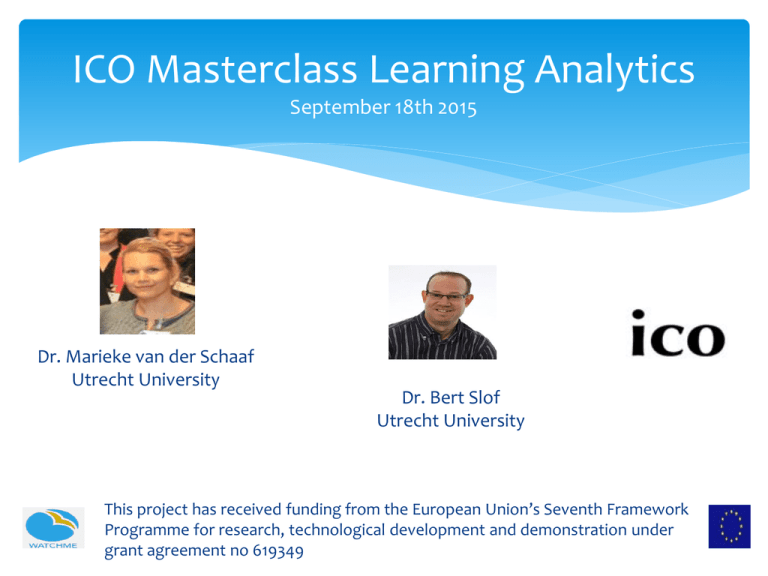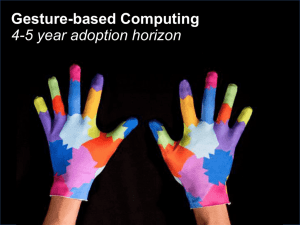here - watchme
advertisement

ICO Masterclass Learning Analytics September 18th 2015 Dr. Marieke van der Schaaf Utrecht University Dr. Bert Slof Utrecht University This project has received funding from the European Union’s Seventh Framework Programme for research, technological development and demonstration under grant agreement no 619349 Aims 1. Gaining insight in the background and characteristics of Learning Analytics. 2. Being able to recognize and to apply characteristics of Learning Analytics in educational contexts. 3. Being able to recognize the strenghts, weaknesses, opportunities, and threats of current LA-enhanced systems. Program 1. Introduction in Learning Analytics (LA) 2. Educational projects based on Learning Analytics - Recognize and apply characteristics 3. Directions for future LA-enhanced systems and research - Swot analysis 1. Introduction Learning Analytics www.amazon.co.uk 1. Introduction Learning Analytics Log-file data can be used to: www.adblockplus.org discover behavioural patterns offer suggestions for new actions develop pedagogical agents predict future behavioural patterns 1. Introduction Learning Analytics Learning Analytics “Measurement, collection, analysis and reporting of data about trainees in their contexts, for the purpose of understanding, and optimising learning and the utilising of environments in which it occurs.” (Solar, 2013). Learning analytics in sports: training and preparing for matches broadcasting matches 1. Introduction Learning Analytics Digital learning environments Feedback loop www.slideshare.net www.intelligentmining.com 1. Introduction Learning Analytics Benefits “Papamitsiou and Economides (2014) highlights that Learning Analytics can be a powerful tool for the adoption of broader educational planning.” – Fernando “I can see it being used in teacher training institutes, but I think a lot of steps still need to be taken, before learning analytics can by incorporated in a good way in education” -Sanne 1. Introduction Learning Analytics Benefits “Learning analytics can be used to put the user in control, not to take control away in an Intelligent Tutoring Systems kind of way, by using attention to alter and suggest, provide awareness and support social links.” –Stijn “The literature confirms that learning analytics can be used in many different ways, and that using learning analytics can have many benefits, of which a lot are still relatively unexplored.” –Michelle “I believe that learning analytics can serve great purposes and provide us with a lot of knowledge about learning behaviour if useful loggings are created.” -Siswa 1. Introduction Learning Analytics Dimensions of Learning Analytics (Greller & Drachsler, 2012) 1. Introduction Learning Analytics “It was not very clear to me what the intended goal of the authors for this model was.” -Michelle 1. Introduction Learning Analytics Learning Analytics process Intervention Visualization Learners Data Analysis (Siemens, 2012) 1. Introduction Learning Analytics Ethical issues www.sclater.com 1. Introduction Learning Analytics Ethical issues “Especially the transparency principle (Slade & Prinsloo, 2013) is (in my opinion) important and the informed consent should provide information about which data will be used, under which conditions, who will have access, etc.” –Ruth “we need to think about the privacy issues” -Sanne “During the first study of my PhD project, I could get access to almost all program information as a visitor of the training platform” -Nan 1. Introduction Learning Analytics Ethical issues “should the actions that students make that are related to the course, but do not happen within the learning environment being collected/monitored?” – Sanne “To what extend can we gather learner actions and information before we harm learners’ privacy?” Siswa 1. Introduction Learning Analytics Ethical issues “As shown in the article of Duval (2011) I think student can get a great overview of their progress and are able to monitor their own activities. Besides that they can actually see what the other students are doing, which can help them to keep up and reflect on their own progress.” – Sanne “if you always can compare your learning process with that of other students, is this motivating for every learner? Or only for a special group of learners? I can imagine that a student that is always ‘behind’ will not like the learning dashboard, and will feel ‘stupid’ instead of being motivated.” –Ruth 1. Introduction Learning Analytics Ethical issues “While as a researcher, we should not only focus on the training records saved in the online platform but also provide opportunities (e.g. individual interviews) for trainees to explain/interpret their own data.” -Nan 2. LA-based Educational projects Learning Analytics Workplace-based learning with digital portfolios: Application of probabilistic student models that enable feedback based on multi sorted assessments Personalized feedback Visualizing learners’ development This project has received funding from the European Union’s Seventh Framework Programme for research, technological development and demonstration under grant agreement no 619349 2. LA-based Educational projects Example digital portfolio 2. LA-based Educational projects Architecture Assessment Arguments (Mislevy, 2006) What task should be assessed and how does the learner develop during the curriculum? What performance indicators should be used to gain insight into a learner’s competence? What instruments should be used to assess the tasks? EARLI CONFERENCE, 27 AUG 2015, LIMASSOL CYPRUS Student Model Evidence Model Task Model 2. LA-based Educational projects Bayesian student model represents the actual internal cognitive state of each learner as well as their actual learning context. contains enough pedagogical knowledge in order to be able to translate the internal state and context into meaningful messages and information for visualization. is a back-end component, meaning that no direct user interaction is made with this module. will make suggestions to help the learners, assessors or supervisors improve their performance. Domain SM vs Individual SM Domain SM (DSM) Will encapsulate all the pedagogical knowledge required to model one domain Possible models are: Anaesthesiology Training, Veterinary Education, Teacher Education and General Undergraduate Medical Education Variations of these proposed models: Veterinary Education (NL vs HU) Teacher Education (NL vs EE) General Undergraduate Medical Education (NL vs DE) EARLI CONFERENCE, 27 AUG 2015, LIMASSOL CYPRUS 23 Domain SM vs Individual SM Individual SM (ISM) Will encapsulate all the pedagogical knowledge required to model one learner. The Individual SM will be a personalized domain model ⚠ One ISM cannot handle more than one domain at once ⚠ For multiple roles of the same individual (e.g. a learner is both a supervisor and a trainee) the ISM will cover only the learner’s role EARLI CONFERENCE, 27 AUG 2015, LIMASSOL CYPRUS 24 2. LA-based Educational projects Example JIT feedback 2. LA-based Educational projects Assignment: web lecture & questions 1) What is the goal and approach of the project? 1) What are the different stakeholders and what is their role in the project? 2) How does the project examine the effects of the LA-enhanced system? 1) What are the projects’ main challenges with respect to the development, implementation, and evaluation of the LAenhanced system? 2. LA-based Educational projects “According to Chatti, Dyckhoff, Schroeder and Thüs (2012) learning analytics deal with the development of methods that harness educational data sets to support the learning process. I think the definitions of Learning Analystics are in general - as I found out in the articles- broad defined.” -Sanne 2. LA-based Educational projects Teaching Analytics 2. LA-based Educational projects Example social support tool 2. LA-based Educational projects Assignment: web lecture & questions 1) What is the goal and approach of the project? 1) What are the different stakeholders and what is their role in the project? 2) How does the project examine the effects of the LA-enhanced system? 1) What are the projects’ main challenges with respect to the development, implementation, and evaluation of the LAenhanced system? 3. Future directions What are the strengths of current LA-enhanced systems? What are the weaknesses of current LA-enhanced systems? What are the opportunities for new LA-enhanced systems? Which threats should be taken into account when developing, implementing, and evaluating the effects of new LA-enhanced systems? Challenges of LA “One of the challenges in this growing domain is to make efficient use of this data. Often, a large amount of educational data is collected, which makes it difficult and complex to search for the real added value. … it is important to know (exactly) in advance the purpose of the use of learning analytics, in order to grasp the (large amount of) data.” –Ruth “One of the big problems around learning analytics is the lack of clarity about what exactly should be measured to get a deeper understanding of how learning is taking place” -Stijn Challenges of LA “learning analytics can also be ineffective and results can be misinterpreted based on which incorrect feedback or other incorrect communication is provided to the learner, which can harm the learner instead of helping him/her.” -Siswa Challenges of LA “The point I would like to make here is that I think the activities of students in the online learning environment does not give a reliable overview of the investments they make when preparing for a course.” – Sanne “I believe that learning analytics, if used for research purposes, should be combined with other sources of information. I think you can retrieve a lot of information from learning analytics, but in order not to disturb learners’ learning processes, other ways of gathering their thoughts and ideas should be used complementary in order to make sense of the logging data.” -Siswa “I am not entirely sure whether I agree that learning analytics only provide a snapshot. I think this really depends on how much data you gather across how many moments. When enough data is gathered, I feel you can have a reasonably accurate profile of a student.” -Michelle Challenges of LA “qualitative data can be retrieved and analyzed in order to have a deeper insight in the learning process. … In my opinion, the qualitative approach has many (undiscovered?) features and opportunities.” –Ruth “in none of those studies the social-cultural aspect of the participants was considered.” -Fernando 3. Future directions How to ensure user privacy? How to present data? How do users interpret the presented data? How to implement a LAenhanced system in schools? www.equest.com Literature suggestions Williamson, B. (2015). Digital education governance: data visualization, predictive analytics, and ‘real-time’ policy instruments, Journal of Education Policy, DOI: 10.1080/02680939.2015.1035758 Ferguson, R., Macfadyen, L.P., Clow, D., Tynan, B., Alexander, S. & Dawson, S. (2014). Setting Learning Analytics in Context: Overcoming the Barriers to Large-Scale Adoption. Journal of Learning Analytics, 1(3), 120–144. Greller, W. & Drachsler, H. (2012). Translating learning into numbers: a generic framework for Learning Analytics. Educational Technology & Society, 15 (3), 42–57. Pardo, A. & Siemens, G. (2014). Ethical and privacy principles for Learning Analytics. British Journal of Educational Technology, 45(3), 438–450. Pechenizkiy M., Gašević, D. (2014). "Introduction into Sparks of the Learning Analytics Future”. Journal of Learning Analytics, 1 (3), 2014, 145-149. Selwyn, N. (2015) Data entry: towards the critical study of digital data and education, Learning, Media and Technology, 40:1, 64-82, DOI: 10.1080/17439884.2014.921628 George Siemens www.educause.edu Rebecca Ferguson www.open.ac.uk Dragan Gašević www.sfu.ca Thank you for your attention! www.home.qrpro.co Dr. Marieke van der Schaaf Utrecht University M.F.vanderSchaaf@uu.nl Dr. Bert Slof Utrecht University B.Slof@uu.nl







